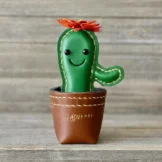Cacti are tough survivors, thriving in harsh deserts with minimal water. They store it in their fleshy bodies, protected by spines that double as sunshades and shields. But they’re not just tough, they’re beautiful too, with vibrant blooms and unique shapes. Some even grace gardens and homes! And get this: innovative minds are turning cacti into sustainable, stylish “Cactus Leather.” So next time you see a cactus, appreciate its resilience, beauty, and surprising trendsetting spirit!

Table of Contents
ToggleWhat is Cactus Leather?
Cactus leather, scientifically known as Opuntia ficus-indica, is a plant-based leather alternative derived from the mature pads of the cactus. This versatile plant is also called the nopal cactus or Indian fig opuntia. Cultivators harvest the material by carefully removing mature pads, ensuring the cactus remains healthy and can produce new growth throughout the year.
The Rise of Cactus Leather Fashion
Fashion is changing in a surprising way, all thanks to desert cacti! These tough plants, known for living in dry places, are now being used to make leather that’s good for the environment. Instead of using animal skin, we’re using cactus skin to make cool things like wallets, bags, shoes, and even car seats. This means we can look stylish while also helping the Earth.
But how does a spiky desert plant become luxurious material? It’s an interesting journey! First, we gather mature Opuntia cacti, especially the prickly pear kind called nopal. We carefully cut the leaves, called pads, from the plant, which helps it grow back strong. Then, we dry and shred these pads and mix them with a natural glue made from corn or cassava. After that, we press the mixture into sheets, add color and texture, and ta-da! We have a material that looks and feels just like regular leather.
Who started the Cactus Leather Business
In the world of cactus leather, Desserto is a leading name. It was started in 2019 by two smart people from Mexico, Adrián López Velarde and Marte Cázarez. Desserto isn’t just a brand; it’s all about using smart ideas to make things better for the environment. They found a special way to turn cactus pads into leather that feels just like the real thing but without hurting the environment. Desserto cares about using natural farming methods, using less water, and using things that can be renewed. This makes it a stand out in the fashion world for being eco-friendly. From wallets to car seats, Desserto’s tells a great story: one where fashion and being good to the Earth go hand in hand, making a positive impact with every stitch.
Benefits:
- Environmental Benefits:
- Fewer greenhouse gases compared to animal leather.
- Cactus leather requires significantly less water to produce compared to traditional leather.
- Cactus leather production does not contribute to deforestation, unlike cattle farming for leather.
- Ecological Benefits:
- Cacti thrive in dry environments and require minimal water, making them environmentally sustainable.
- Cacti help absorb carbon dioxide from the air, contributing to cleaner air and reducing greenhouse gas levels.
- Ethical Benefits:
- Cactus leather is cruelty-free, alleviating concerns about animal welfare associated with animal leather production.
- Cactus leather supports communities in dry regions by creating employment opportunities and promoting sustainable farming practices.
- Durability and Flexibility: Cactus leather is highly durable and can withstand heavy wear and tear for many years. It’s resistant to abrasion, rubbing, tearing, and water, and can handle humidity and liquids well. Cactus leather is also mold and mildew resistant, and can protect against environmental damage from rain or snow. So, is cactus leather the same as animal leather? Yes, cactus leather is similar to animal leather in terms of texture, durability, and appearance.
Challenges:
- Newness: Cactus leather is still in its early stages of development and not produced in large quantities.
- Cost: Currently, cactus leather can be more expensive than traditional leather due to limited production, but prices are expected to decrease as production scales up.
Future of Cactus Leather
Even though there are difficulties, the future of cactus leather looks good! Fashion giants like Stella McCartney and Adidas have already embraced the material, showcasing its versatility and potential. Luxury brands are exploring its use in high-end accessories, while innovative startups are developing cactus-based alternatives for other leather applications, like watch straps and furniture coverings.
The growing demand for sustainable fashion will undoubtedly propel cactus leather into the mainstream. Its unique story, environmental benefits, and ethical appeal resonate with consumers increasingly conscious of the impact of their choices. From desert patches to designer boutiques, the journey of the prickly cactus is poised to rewrite the narrative of the fashion industry, one stitch at a time.

Pingback: Cactus Jack!
Pingback: Cactus Poetry
Pingback: What is a Cactus – Definition & Meaning
Pingback: Why Your Dog Deserves a Cactus Leather Bed?
Pingback: Is Cactus Leather better than Traditional Leather?
Pingback: The Cool Cactus Bag Everyone Loves